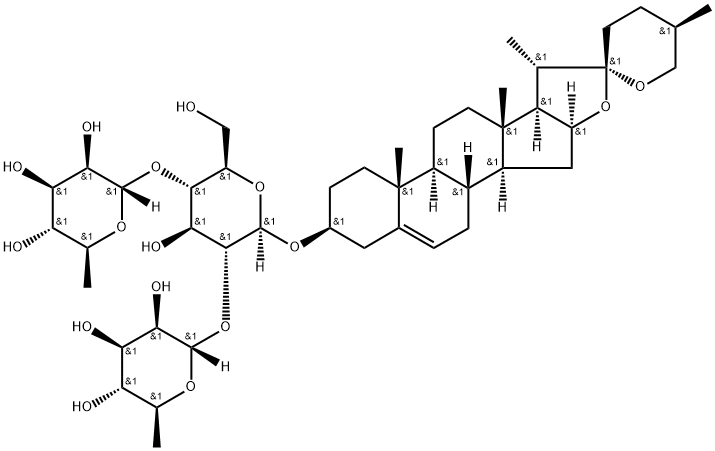Dioscin C화학적 특성, 용도, 생산
개요
Dioscin is extracted from Dioscorea nipponica. Rhizoma Dioscoreae Nipponicae is
the dry rhizome of this plant. It can be orally used to treat joint pain, arthritis,
malaria, and chronic bronchitis. In addition, it can also be used externally to treat
sore carbuncle swollen. Rhizoma Dioscoreae Nipponicae is commonly used in the
northeast region, Shanxi province, and Shandong province of China.
물리적 성질
Appearance: white powder. Solubility: insoluble in water, petroleum ether, and benzene; soluble in methanol, ethanol, and acetic acid; slightly soluble in acetone and
amyl alcohol. Melting point: 294–296℃. Specific optical rotation: ?115°
(c?=?0.373, ethanol).
역사
Japanese scientists firstly reported and analyzed the structure of dioscin isolated
from the saponins of Japanese Dioscoreaceae. V . However, the biological activities of dioscin have not attracted the interests of scientists until the late 1990s and
the beginning of this century. It is now believed that dioscin may have therapeutic
effects on reducing blood lipids and protecting the liver, as well as antivirus, antiinflammatory, and antitumor effects. After the implementation of standardization of
traditional Chinese medicine, dioscin as the quality control specification of
Dioscorea nipponica Makino and other traditional Chinese medicine has attracted
more attentions and researches. In China, dioscin tablets have been used to treat
hyperlipidemia in the clinical practice. However, no corresponding drugs are available on the market in other countries. In addition, dioscin is also an important predecessor for synthesizing steroid hormones . Dioscorea nipponica Makino,
which is used to extract dioscin, primarily comes from wild plants, whose resources
are limited.
Indications
This drug was recorded in the national standards for chemical drugs, volume 5.
Dioscin tablets, containing total dioscin, are used to treat coronary heart disease,
coronary insufficiency, as well as control hyperlipidemia.
Pharmacology
Studies showed that compound preparations containing dioscin can increase coronary blood flow, reduce myocardial oxygen consumption, and protect myocardial
ischemia and ischemia-reperfusion injury, which is beneficial for alleviating myocardial ischemia and angina. In addition, dioscin can regulate the lipid metabolism
and improve hemodynamics. Dioscin can also prevent atherosclerosis by reducing
serum total cholesterol, triglyceride, low-density lipoprotein, and oxidized lowdensity lipoprotein, reducing the whole blood viscosity and plasma viscosity at high
and low shear rates, and relieving arterial wall lipid infiltration and plaque formation. Furthermore, dioscin can reduce liver fat deposition, which may be related to
promoting cholesterol secretion metabolism.
It has also been reported that dioscin can induce the apoptosis of a variety of
tumor cells, including gastric cancer cells, breast cancer cells, lung cancer cells, oral
squamous cell carcinoma, and cervical cancer cells. The mechanisms are related to
reducing the oxidative stress and inhibiting some cellular survival signaling pathways
Dioscin can induce antioxidant enzymes, lower blood lipids, improve insulin
resistance, inhibit the inflammatory response, reduce the damage of alcoholic hepatitis, and decrease the hepatic injury induced by acetaminophen .
Dioscin 준비 용품 및 원자재
원자재
준비 용품







